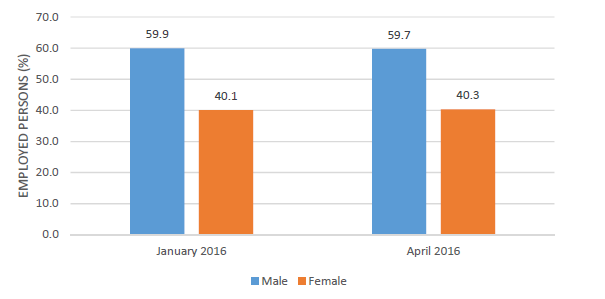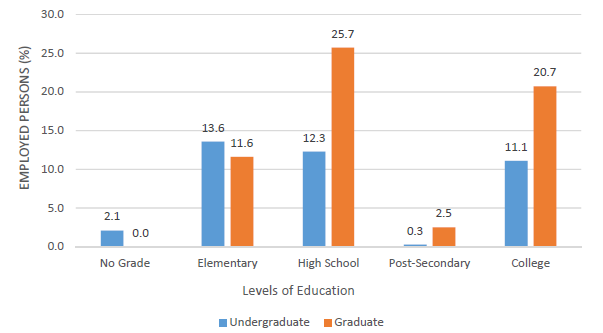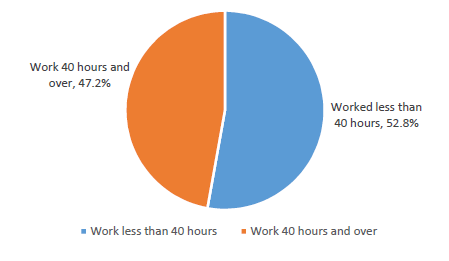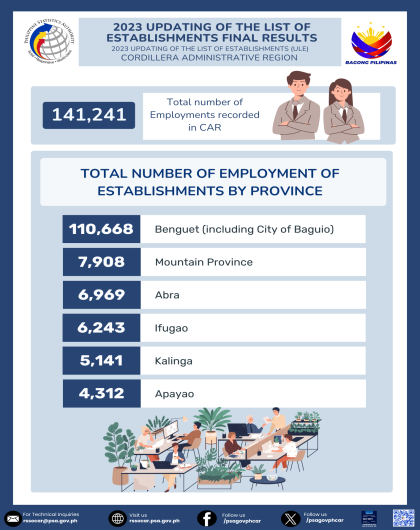- The Labor Force Survey (LFS) provides a snapshot or the stock of economically active persons in the country at a particular point or reference period. It aims to monitor the changes in the employment status of persons in the working age population (employed, unemployed and not in the labor force) during a specified time period using the Labor Force Framework.
-
The LFS concept and measurement follows the international standards concerning statistics of the economically active population, employment, unemployment and underemployment adopted by the 13th International Conference of Labour Statisticians (ICLS) in October 1982 at Geneva, Switzerland.
CAR Labor Force Participation Rate (LFRP) is 65.9%
-
The results of the April 2016 Labor Force Survey showed that the Philippines’ labor force participation rate of persons whose age is 15 years old and over was estimated at 63.5 percent or about 43.28 million.
-
Cordillera Administrative Region (CAR) was among the region with an LFPR higher than the national rate.
-
Central Visayas had the highest LFPR of 68.0 percent translated to about 3,442,000 persons in the labor force.
-
The region’s LFPR decreased by 1.1 percentage point from 67.0% in January 2016 to 65.9 percent in April 2016.
Table1. Labor Force Participation Rate, Top 4 Regions: April 2016
| Country / Region | Total Population 15 years Old and Over |
Total Labort Force | Labor Force Participation Rate (LFPR) (%) |
|---|---|---|---|
| Philippines | 68,167, 000 | 43, 289, 000 | 63.5 |
| Region VII: Central Visayas | 5, 060, 000 | 3, 442,000 | 68.0 |
| Region X: Northern Mindanao | 3, 154, 000 | 3, 154, 000 | 67.9 |
| CAR | 1, 211, 000 | 798, 000 | 65.9 |
| CARAGA | 1, 796, 000 | 1, 796, 000 | 65.3 |
Source: January 2016 and April 2016 Labor Force Survey, Philippine Statistics Authority
Employment Rate in CAR Increased by 0.4%
-
The number of employed persons increased by 0.4 percentage point from 95.6 percent in January 2016 to 96.0 percent in April 2016.
Table2. Percentage of Employed Persons in the Labor Force of CAR:
January 2016 and April 2016
| Labor Force Participation Rate | Employment Rate | |||
|---|---|---|---|---|
| January 2016(%) | April 2016 (%) | January 2016 (%) | April 2016 (%) | |
| Philippines | 63.3 | 63.5 | 94.2 | 93.9 |
|
CAR |
67.0 | 65.9 | 95.6 | 96.0 |
Source: January 2016 and April 2016 Labor Force Survey, Philippine Statistics Authority
More Males Employed in CAR
-
Of the 766,000 employed persons in CAR for April 2016, 59.7 percent were males while 40.3 percent were females.
-
Employed males in the region decreased by 0.2 percentage point from the 59.9 percent employed in January 2016 to 59.7 percent in April 2016.
-
On the other hand, employed females increased by 0.2 percentage point from 40.1 percent employed females in January 2016 to 40.3 percent in April 2016.
Figure 1. Percentage of Employed Persons by SEX, CAR:
January 2016 and April 2016
Employment by Educational Attainment
-
As to educational attainment of employed persons, 38.0 percent had high school education of which 25.7 percent graduated while 12.3 percent did not graduate.
-
Employed persons with college education followed with 31.8 percent of the total employed persons in the region. Of these, 20.7 percent graduated while 11.1 percent did not finish college.
-
Employed persons with elementary level education came third with a share of 25.2 percent, of which 11.6 percent graduated while 13.6 percent did not graduate.
-
Employed persons with Post-Secondary level education accounted to only 2.8 percent of the total employed persons in the region. There were 2.5 percent employed persons who graduated while 0.3 percent were undergraduates.
-
The percentage of employed persons in CAR for April 2016 with no education or grade level completed was at 2.1 percent. This level had the lowest incidence of employment in the region.
Figure 2. Employed Persons by Highest Grade Completed, CAR:
April 2016
Source: April 2016 Labor Force Survey, Philippine Statistics Authority
Agriculture Industry Employs the Most
-
Agriculture and Forestry continued to be the biggest employer in the region with 44.3 percent share in April 2016. The share of the industry increased by 0.4 percentage point compared to January 2016.
-
Wholesale and retail trade; repair of motor vehicles and motorcycles ranked as the second largest major industry group with 11.2 percent of the total employed persons in April 2016.
-
Public Administration and Defense made up the third largest major industry group accounting for 7.5 percent in April 2016.
-
Manufacturing shared only 3.0 percent of the total employed persons in the region in April 2016 considering that this sub-industry group contributes the most to the regional economy.
Table3. Employed Persons by Major Industry Groups in CAR:
January 2016 and April 2016
| Major Industry Group | January 2016 | Share (%) | April 2016 | Share (%) |
|---|---|---|---|---|
| Total of Employed Persons | 765, 000 | 100.0 | 766,000 | 100.0 |
| Agriculture and Forestry | 336, 000 | 43.9 | 339, 000 | 44.3 |
| Wholesale and Retail Trade; Repair of Motor Vehicles and Motor Cycles |
95, 000 | 12.4 | 86, 000 | 11.2 |
| Public Administration and Defense; Compulsory Social Security |
58, 000 | 7.6 | 57, 000 | 7.5 |
| Construction | 59, 000 | 7.7 | 54, 000 | 7.1 |
| Transportation and Storage | 32, 000 | 4.2 | 35, 000 | 4.6 |
| Accomodation and Food Service Activities | 22, 000 | 2.9 | 17, 000 | 2.2 |
| Education | 35, 000 | 4.6 | 34, 000 | 4.5 |
| Other Service Activities | 31, 000 | 4.0 | 28, 000 | 3.6 |
| Administrative and Support Service Activities | 22, 000 | 2.9 | 17, 000 | 2.2 |
| Manufacturing | 17, 000 | 2.2 | 23, 000 | 3.0 |
| Minig and Quarrying | 20, 000 | 2.6 | 31, 000 | 4.1 |
| Human Health and Social Work Activities | 8, 000 | 1.0 | 11, 000 | 1.4 |
| Financial and Insurance Activities | 4, 000 | 0.5 | 5, 000 | 0.6 |
| Information and Communication | 7, 000 | 0.9 | 8, 000 | 1.0 |
| Arts Entertainment and Recreation | 4, 000 | 0.5 | 5, 000 | 0.6 |
| Professional Scientific and Technical Activities | 3, 000 | 0.4 | 2, 000 | 0.3 |
| Electricity Gas Steam and Air-Conditioning Supply | 2, 000 | 0.3 | 3, 000 | 0.4 |
| Water Supply; Sewerage Waste Management and Remediation Activities |
1, 000 | 0.1 | 1, 000 | 0.1 |
| Fishing and Aquaculture | 1, 000 | 0.1 | 1, 000 | 0.1 |
| Real Estate Activities | * | * | 1, 000 | 0.1 |
| Activities of Household as Employers; Undifferntiated Goods - and Services - Producing Activities of Housholds for own use |
- | 0 | - | 0 |
| Activities of Extraterritorial Organizations and Bodies | - | 0 | - | 0 |
Laborers and Unskilled Workers Comprise 29.8%
-
Among the occupation groups, laborers and unskilled workers remained to be the largest group of employed persons in CAR with 29.8 percent of the total regional employment in April 2016. This decreased by 3.5 percentage points compared to January 2016.
-
Farmers, forestry workers, and fishermen ranked as the second largest occupation group with 22.6 percent of the total employed persons in April 2016, which increased by 1.56 percentage points from January 2016.
-
Officials and employees of the government and special Interest organizations, corporate executives, managers, managing proprietors, and supervisors made up the third largest occupational group accounting for 12.5 percent in April 2016.
-
The rest of the major occupation groups comprised 35.1 percent of the total employed persons in the entire labor force of the region in April 2016.
Table4. Employed Persons by Major Occupation Groups in CAR:
January 2016 and April 2016
| Major Occupation Groups | January 2016 | Share (%) | April 2016 | Share (%) |
|---|---|---|---|---|
| Total of Employed Persons | 765, 000 | 100.00 | 766, 000 | 100.00 |
| Laborers and Unskilled Workers | 255, 000 | 33.3 | 228, 000 | 29.8 |
| Farmers, Forestry Workers and Fishermen | 161, 000 | 21.0 | 173, 000 | 22.6 |
| Officials of Governement and Special Interest Organizations, Corporate Executives, Managers, Managing Proprietors, and Supervisors |
104, 000 | 13.6 | 96, 000 | 12.5 |
| Service Workers and Shop and Market Sales Workers | 65, 000 | 8.5 | 77, 000 | 10.0 |
| Professionals | 44, 000 | 5.7 | 51, 000 | 6.6 |
| Trade and Related Workers | 46, 000 | 6.0 | 37, 000 | 4.8 |
| Clerks | 34, 000 | 4.4 | 31, 000 | 4.0 |
| Plant and Machine Operators and Assemblers | 22, 000 | 2.9 | 50, 000 | 6.5 |
| Technicians and Associate Professionals | 29, 000 | 3.8 | 22, 000 | 2.9 |
| Special Occupations | 5, 000 | 0.7 | 3, 000 | 0.4 |
Source: January 2016 and April 2016 Labor Force Survey, Philippine Statistics Authority
Underemployment at 22.9 %
- The underemployment rate of CAR was 22.9 percent and the visible underemployment rate was 12.1 percent for April 2016.
-
The total underemployment in CAR was 176,000 of which 47.2 percent of the underemployed persons already worked 40 hours per week and over.
-
Meanwhile, those who work less than 40 hours a week accounted 52.8 percent of the total underemployed population in the region.
Figure 2. Employed Persons by Highest Grade Completed, CAR:
April 2016
Source: April 2016 Labor Force Survey, Philippine Statistics Authority
Unemployment
-
Unemployment rate in the region decreased by 0.25 percentage point, from 4.2 percent in January 2016 to 4.0 percent in April 2016.
-
The unemployed male population accounted for 56 percent of the total unemployed persons in the region, while 44 percent were unemployed females.
Table5. Distribution of Unemploymed Persons by Sex in CAR: April 2016
| Unemployed Persons | Percentage | |||
|---|---|---|---|---|
| January 2016 | April 2016 | January 2016 | April 2016 | |
| Male | 16, 000 | 18, 000 | 47% | 56% |
|
Female |
18, 000 | 14, 000 | 53% | 44% |
| CAR | 34, 000 | 32, 000 | 100% | 100% |
Source: January 2016 and April 2016 Labor Force Survey, Philippine Statistics Authority
Technical Notes
In the Labor Force or Economically Active Population -This refers to population 15 years old and over who are either employed or unemployed in accordance with the definitions described below.
Employed Persons - Persons who, during the reference period are 15 years and over as of their last birthday and are reported either:
-
At work - Those who do any work even for one hour during the reference period for pay or profit, or work without pay on the farm or business enterprise operated by a member of the same household related by blood, marriage or adoption; or
-
With a job but not at work - Those who have a job or business but are not at work because of temporary illness/injury, vacation or other reasons. Likewise, persons who expect to report for work or to start operation of a farm or business enterprise within two weeks from the date of the enumerator's visit are considered employed.





